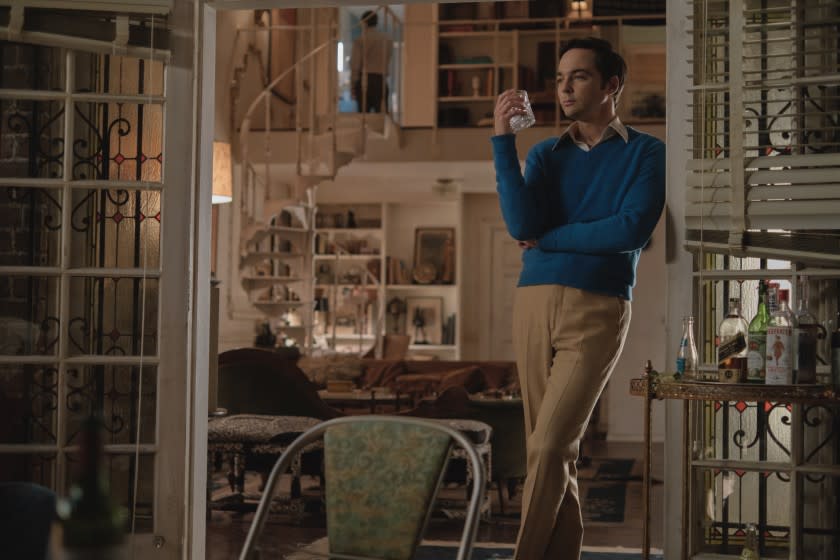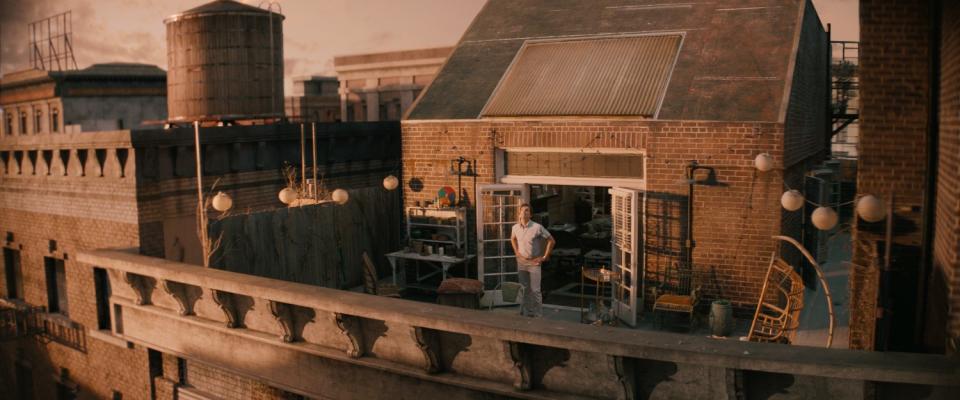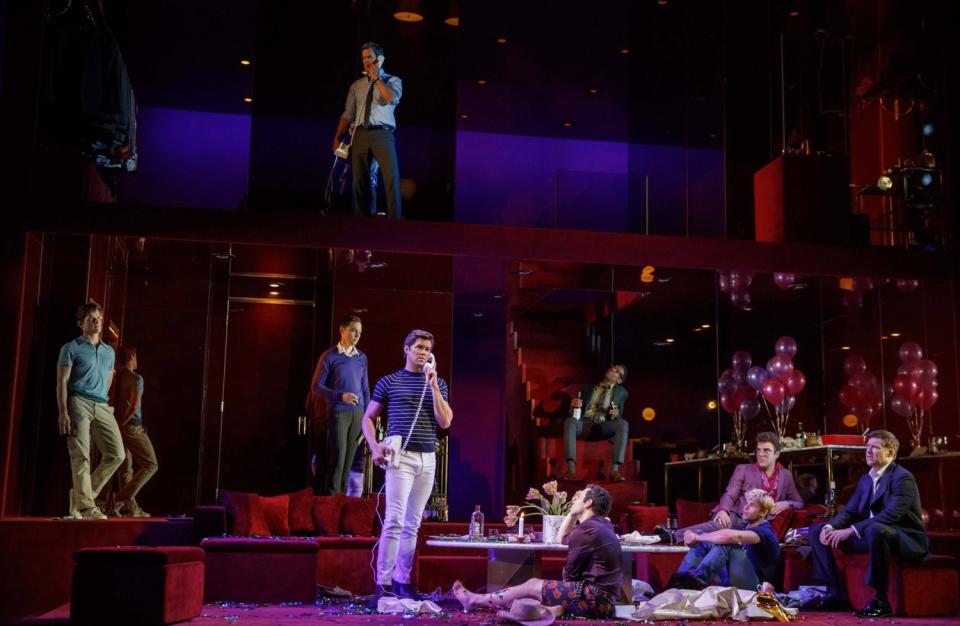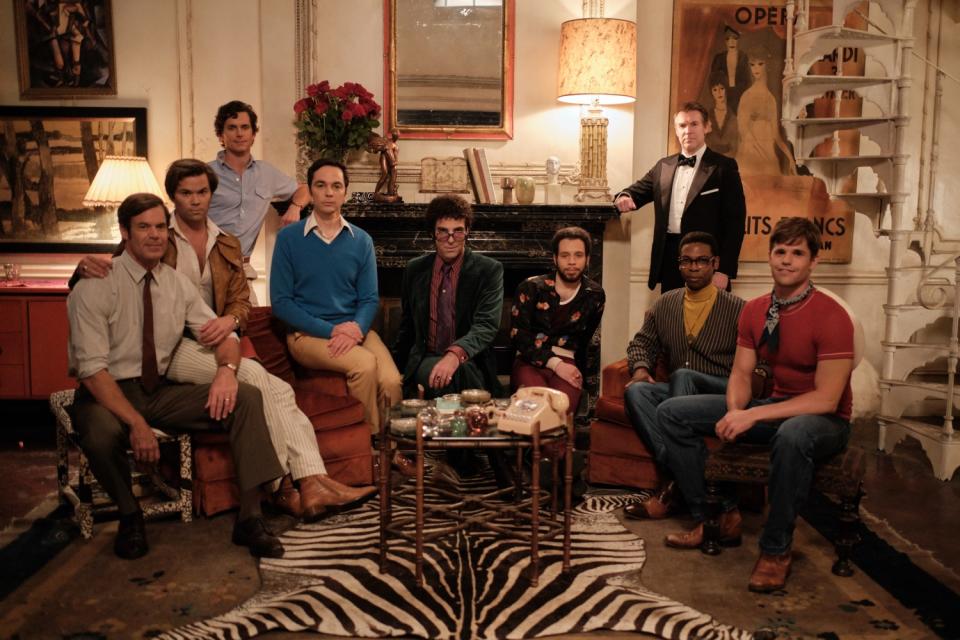Why Netflix's 'The Boys in the Band' gave the landmark play a quietly hopeful ending

[Warning: The following story contains minor spoilers for "The Boys in the Band," including a discussion of the ending, now streaming on Netflix.]
It hadn't yet been a year since Jim Parsons simulated a nervous breakdown — eight times a week for over three months — in the Broadway revival of "The Boys in the Band." Yet he found himself intimidated when he first walked onto the set of the Netflix movie.
"I'll be honest — I thought, 'Oh, s—, this apartment is so perfect. Can I ever live up to playing the character who lives here?'" he told The Times of the intricate prewar New York apartment erected at Sunset Gower Studios. "All the clothes in his closet with the tags still on, the original Playbills all over his desk, the shaving cream in his sad little medicine cabinet. Imagining him waking up in that bedroom after a late night of drinking ..."
This sumptuous but rundown multistory dwelling becomes a crucial storytelling tool in this version of Mart Crowley's 1968 play. Though the landmark drama was previously adapted for the screen in 1970, "It was not a period movie," said Judy Becker, the production designer of the new film. "While that space looks really real — a little cluttered and messy and very believable — looking at it, I wouldn't have known what year it was. We wanted to keep that realness, but really reflect the moment and the character who lives there.”
Becker modeled Michael's home after her aunt's Upper West Side brownstone, with its ballroom-style living room, spacious outdoor terrace and indelible sense of grandeur. Its decor — eclectic in taste but disheveled in display — is a physical manifestation of Michael's obsession with luxuries he can't necessarily afford.
"This is a person who gets so much joy from buying beautiful things, even if he doesn't have the storage for it," said set decorator Gene Serdena, who re-created bags of then-major department stores and found vintage Hermès boxes on EBay. "His sweaters are stuffed between shelves, shopping bags are hanging on the door. He's perpetuating a delusion of aspiration and fabulousness to the point that it's practically encroaching on him."

It is here that Michael gathers his closest friends for a party, with Zachary Quinto as the birthday boy and Matt Bomer and Andrew Rannells as some of the invited guests. Their raised eyebrows and silent eyerolls are all as important as the jokes and insults that triggered them.
"Sometimes the most important person in a particular scene is the one who isn't speaking but observing," said Joe Mantello, who directed the Broadway revival and the new film. "The text of the play is exactly the same as it's always been, but the camera could be capturing something else entirely. Those things can now coexist in a way that was slightly more complicated to pull off onstage."
After blowing out the candles, drinking too much and, of course, dancing to Martha and the Vandellas' "Heat Wave," the group rushes in to avoid a sudden storm. The group of gay men are then trapped in that ornamented living room with an unexpected guest and individual internalized homophobia.
"All the doors were closed, and I take a deep breath even just telling you about the feeling of claustrophobia I had," recalled Parsons of the two weeks it took to film the emotional climax. "In the theater, we could release that energy out to the huge audience, at least. But we were all in that room and playing that telephone game, just going in on each other and in on each other. It brought an added intensity and cruelty to certain moments, but [damn] was it helpful."

Usually, the viewer is left in that room too as the story — onstage and in the initial film — ends with Michael wiping his tears, speaking of hopelessness and slamming the door. "The original ending is absolutely brilliant, but it's like a punch in the gut," said Mantello. "There's no mercy at the end of it, and it's really powerful because it's so harsh. What we know now is that Stonewall was a year away — so this anger was bubbling up and about to explode, and the rage was bigger than that room.
"But what was also in that room was — like when Zachary Quinto['s character] says, 'Call you tomorrow' — that grace and gentleness and forgiveness," he continued. "These people are friends, and they're acting out because of what the world has turned them into. I wanted that spirit of camaraderie in the last minutes of the film to help mitigate the savagery of all the shame."
Mantello worked with journalist and screenwriter Ned Martel on the movie's closing moments, which follow each of the men after the party in a similar way that the opening showed them beforehand. Bernard and Emory head to a diner, Harold and the Cowboy take a cab, Donald reads "The Golden Notebook," Doris Lessing's trailblazing novel about yearning for connection amid a fragmented society and self.
"I think it's important to show that, even though they're up against something monumental, they're all still standing," said Mantello, especially as "Boys in the Band" debuted when homosexual characters in plays and movies customarily committed suicide. "That way, you're not just seeing a litany of moments of self-hatred. There are moments of bravery and courage; there are moments of trying to assert your own value in a world that is telling you the exact opposite."

Once outside his apartment, Michael attends a midnight mass at St. Malachy’s and then walks down an empty street, seemingly deep in thought. With the camera behind him, he removes his hands from his pockets and breaks out into a run. It's a quietly hopeful coda that, while open to interpretation, adds something to the oft-debated text without anyone uttering a word. "It's not a given that one falls to a rock bottom like that and then sees a light and can make a healthy move," said Parsons.
"Or maybe it's just that we know, as an audience, the actual lives being led by the gay actors in this cast, which is in the room no matter how true to the text we are," he wondered, since many of the original movie's actors couldn't get work afterward.
For this adaptation to feature a full cast of openly gay actors — whose careers haven't necessarily been stifled by coming out — is what Parsons called "profound," especially given what each of them has experienced before entering Michael's apartment.
"The time I spent with this character forced me to take a look at my own self and all the ways in which I had internalized homophobia throughout my life," he said. "I by no means live in a society like Michael did then, so I by no means have quite the deep cuts that he does. But I have some. And I've come to realize how much more I'm still in a continual process of accepting who I am. It was one of the more positive experiences of my career, and I really treasure it."
For the record:
10:38 AM, Oct. 01, 2020: Set decorator Gene Serdena was erroneously identified as Gene Becker.


